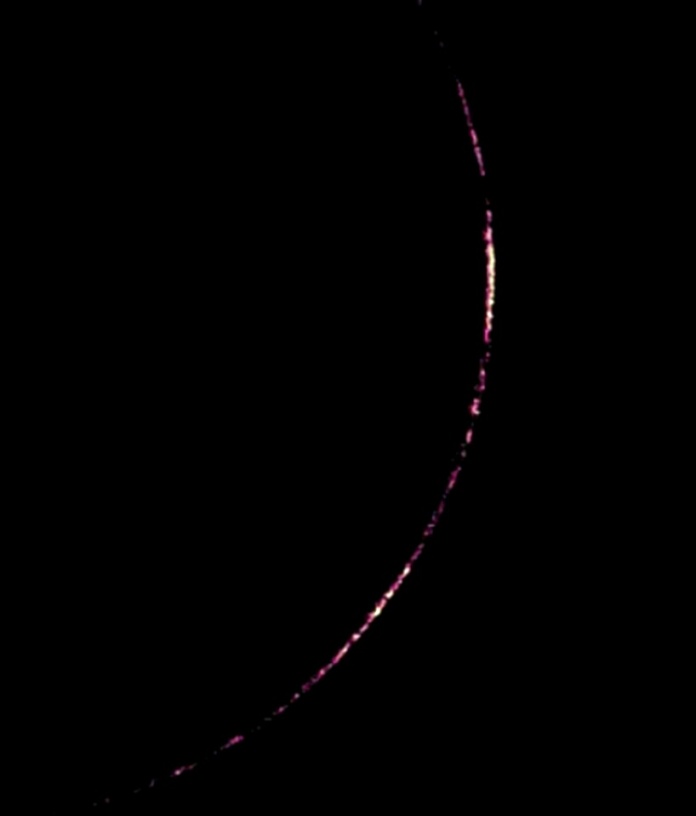
by stephen saber
i’m mostly a deepsky guy, but fortunately i also developed a comparable obsession with planetary, lunar, and doublestar study. this saved my mental health on countless nights of less-than-galaxy-class skies. the abundance of doubles make them a particularly satisfying complement to dso hunting.
the following gems all have secondaries brighter than 8th mag. most are obvious enough not to need position angles to locate. corresponding pocket sky atlas charts are included. apparent colors can vary depending on sky conditions, contrast, magnitude difference, color sensitivity, and aperture used. enjoy!
gamma And 0204+4219 mag 2.3, 5.5 @ sep 9.7″ orange and blue (psa 02)
12 Aqr 2104-0549 5.8, 7.5 @ 2.5″ yellow and blue (77)
94 Aqr 2319-1327 5.3, 7.3 @ 13.0″ red and light blue (76)
107 Aqr 2346-1840 5.4, 5.7 @ 7.0″ white and blue (76)
1 Ari 0150+2216 5.8, 7.1 @ 2.8″ white and blue/green (04)
gamma Ari 0154+1917 4.6, 4.7 @ 7.6″ orange and blue/green (04)
lambda Ari 0158+2336 4.8, 7.6 @ 37.5″ yellow and blue (04)
30 Ari 0237+2439 6.2, 7.2 @ 39″ yellow and blue (04)
stf872 Aur 0616+3609 6.0, 7.0 @ 11.3″ gold and blue (12)
14 Aur 0515+3241 5.4, 7.5 @ 14.0″ yellow and orange (12)
epsilon Boo 1445+2704 2.5, 4.9 @ 2.8″ yellow/orange and blue (53)
xi Boo 1451+1905 4.7, 7.0 @ 6.9″ yellow and red (55)
beta Cap 2021-1446 3.2, 6.2 @ 205″ orange/yellow and blue (66)
sigma Cas 2359+5545 5.0, 7.1 @ 3.1″ blue and blue/green (03)
stf3053 Cas 0003+6606 5.9, 7.3 @ 15.2″ orange and white (01)
eta Cas 0049+5749 3.7, 7.5 @ 12.8″ yellow, white, red (03)
iota Cas 0229+6724 4.6, 6.9 @ 2.5″ white, orange triple (01)
beta Cep 2129+7034 3.2, 7.9 @ 13.3″ white and blue (71)
delta Cep 2229+5824 3.9, 6.3 @ 41″ orange and blue (71)
stf2816 Cep 2139+5729 5.7, 7.5 @ 11.7″ triple with stf2819 (73)
iota Cnc 0847+2845 4.2, 6.6 @ 30″ yellow/gold and blue (24)
h3945 CMa 0717-2319 4.8, 6.0 @ 26.8″ orange and blue (27)
17 Com 1229+2554 5.4, 6.7 @ 145″ white and blue (45)
24 Com 1235+1822 5.2, 6.7 @ 20.3″ gold and blue (45)
zeta CrB 1539+3638 5.1, 6.0 @ 6.3″ white and blue (53)
alpha CVn 1256+3818 2.9, 5.8 @ 19.4″ blue and white (32)
beta Cyg 1931+2757 3.1, 5.1 @ 34.4″ blue and gold (62)
31 Cyg 2014+4644 3.8, 4.8 @ 107″ orange, blue, blue (62)
52 Cyg 2046+3043 4.3, 5.0 @ 6.5″ yellow and orange (62)
gamma Del 2047+1607 4.3, 5.2 @ 9.3″ yellow and blue/green (64)
omicron Dra 1851+5923 4.5, 7.5 @ 34.2″ orange and blue (63)
32 Eri 0354-0257 4.7, 6.2 @ 6.8″ yellow and blue/green (17)
38 Gem 0655+1311 4.7, 7.7 @ 7.1″ white and orange (25)
alpha Her 1715+1423 3.2, 5.4 @ 4.7″ orange and blue/green (54)
kappa Her 1609+1703 5.3, 6.5 @ 28″ yellow and orange (55)
95 Her 1802+2135 5.0, 5.1 @ 6.3″ orange and blue/green (65)
tau1 Hya 0929-0246 4.6, 7.2 @ 66″ white and blue (37)
gamma Leo 1020+1950 2.5, 3.5 @ 4.4″ yellow and gold (35)
tau Leo 1128+0250 5.2, 7.0 @ 90″ yellow and blue (34)
gamma Lep 0545-2227 3.8, 6.5 @ 95″ yellow and red (16)
zeta Lyr 1845+3736 4.3, 5.9 @ 44″ red and blue/green (63)
shj282 Lyr 1855+3358 6.1, 7.7 @ 45″ yellow and blue (63)
beta Mon 0629-0702 4.6, 5.0, 5.4 @ 6.9, 2.8″ (27)
epsilon Mon 0624+0435 4.4, 6.7 @ 12.4″ red and blue/green (25)
omicron Oph 1718-2417 5.2, 6.6 @ 10.3″ yellow/orange and blue (56)
70 Oph 1806+0230 4.2, 6.0 @ 4.0″ yellow and orange (65)
sigma Ori 0539-0236 4.0, 6.5, 7.5, 10.0 @ 12.9, 11.5, 42″ (16) varied shades of blue
eta Ori 0524-0224 3.4, 4.9 @ 1.7″ white and blue (16)
iota Ori 0535-0554 2.8, 7.0 @ 11.3″ white and blue/green (16)
alpha Sco 1630-2626 1.0, 5.4 @ 2.6″ orange and blue/green (56)
beta Sco 1605-1948 2.6, 4.9 @ 13.7″ with omega sco (56)
iota Tri 0212+3018 5.3, 6.9 @ 3.9″ yellow and blue (02)
* * * * *
[31 cyg courtesy of sdss]
tinyurl.com/saberdoesthestarz
tinyurl.com/c14isawesome






















